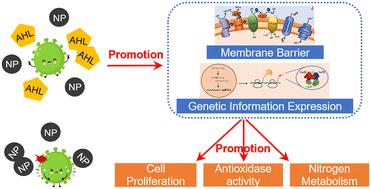当前位置:
X-MOL 学术
›
Environ. Sci.: Nano
›
论文详情
Our official English website, www.x-mol.net, welcomes your
feedback! (Note: you will need to create a separate account there.)
Exogenous N-acyl-homoserine lactone-based quorum sensing regulation benefits Nitrosomonas europaea resistance to CeO2 nanoparticle acute stress
Environmental Science: Nano ( IF 5.8 ) Pub Date : 2022-08-05 , DOI: 10.1039/d2en00250g Huan Gao 1, 2 , Junkang Wu 1, 3 , Yan Chang 4 , Jinyu Ye 1, 2 , Guangping Yang 5 , Ran Yu 1, 2
Environmental Science: Nano ( IF 5.8 ) Pub Date : 2022-08-05 , DOI: 10.1039/d2en00250g Huan Gao 1, 2 , Junkang Wu 1, 3 , Yan Chang 4 , Jinyu Ye 1, 2 , Guangping Yang 5 , Ran Yu 1, 2
Affiliation

|
Adverse effects of nanoparticles (NPs) on biological nitrogen removal (BNR) systems have been extensively explored. However, little information is available on the system's resistance capacity and its improvement strategy to NP stress. We systematically investigated the effects and mechanisms of exogenous N-acyl-homoserine lactones (AHLs) with three different acyl-side chain lengths (N-hexanoyl-L-homoserine lactone (C6-HSL), N-decanoyl-L-HSL and N-tetradecanoyl-DL-HSL) at different concentrations on the resistance of Nitrosomonas europaea to acute CeO2 NP stress. All three AHLs promoted the NP-stressed cellular viabilities, ammonia oxidation performances, and superoxide dismutase activities. The required AHL dose to achieve the optimal anti-toxicity performance depended on its type. The shorter the acyl-side chain length, the lower the optimal acting concentration needed. 0.01 μM C6-HSL achieved the best cellular resistance capacity to CeO2 NP stress. The stimulations of the sulfate transport and metabolism in the presence of C6-HSL promoted the posttranslational modification related to the Fe–S cluster assembly, thus stimulating the electron transfer and aerobic respiration, which synergized with the facilitated ribosomal protein biosynthesis to improve the stressed cellular growth. Meanwhile, the activation of phospholipid transport and chaperone participation related to stress resistance maintained the membrane homeostasis that was actively involved in the promotion of the cellular resistance to NP stress. These findings would inspire a feasible strategy development of AHL-based QS regulation to alleviate NP stress for impaired BNR systems.
中文翻译:

基于外源 N-酰基高丝氨酸内酯的群体感应调控有益于欧洲亚硝化单胞菌对 CeO2 纳米颗粒急性应激的抗性
纳米粒子 (NPs) 对生物脱氮 (BNR) 系统的不利影响已被广泛研究。然而,关于该系统的抵抗能力及其对NP胁迫的改进策略的信息很少。我们系统地研究了具有三种不同酰基侧链长度(N-己酰基-L-高丝氨酸内酯(C 6 -HSL )、N-癸酰基-L- HSL和不同浓度N-十四烷酰基-DL - HSL)对欧洲亚硝化单胞菌对急性CeO 2抗性的影响NP 压力。所有三种 AHLs 都促进了 NP 胁迫的细胞活力、氨氧化性能和超氧化物歧化酶活性。达到最佳抗毒性性能所需的 AHL 剂量取决于其类型。酰基侧链长度越短,所需的最佳作用浓度越低。0.01 μMC 6 -HSL对CeO 2 NP应力的细胞抵抗能力最好。C 6存在下对硫酸盐转运和代谢的刺激-HSL促进了与Fe-S簇组装相关的翻译后修饰,从而刺激了电子转移和有氧呼吸,这与促进的核糖体蛋白生物合成协同作用,改善了受压的细胞生长。同时,与应激抗性相关的磷脂转运和伴侣参与的激活维持了膜稳态,这积极参与了促进细胞对 NP 应激的抗性。这些发现将激发基于 AHL 的 QS 调节的可行策略开发,以减轻受损 BNR 系统的 NP 压力。
更新日期:2022-08-05
中文翻译:

基于外源 N-酰基高丝氨酸内酯的群体感应调控有益于欧洲亚硝化单胞菌对 CeO2 纳米颗粒急性应激的抗性
纳米粒子 (NPs) 对生物脱氮 (BNR) 系统的不利影响已被广泛研究。然而,关于该系统的抵抗能力及其对NP胁迫的改进策略的信息很少。我们系统地研究了具有三种不同酰基侧链长度(N-己酰基-L-高丝氨酸内酯(C 6 -HSL )、N-癸酰基-L- HSL和不同浓度N-十四烷酰基-DL - HSL)对欧洲亚硝化单胞菌对急性CeO 2抗性的影响NP 压力。所有三种 AHLs 都促进了 NP 胁迫的细胞活力、氨氧化性能和超氧化物歧化酶活性。达到最佳抗毒性性能所需的 AHL 剂量取决于其类型。酰基侧链长度越短,所需的最佳作用浓度越低。0.01 μMC 6 -HSL对CeO 2 NP应力的细胞抵抗能力最好。C 6存在下对硫酸盐转运和代谢的刺激-HSL促进了与Fe-S簇组装相关的翻译后修饰,从而刺激了电子转移和有氧呼吸,这与促进的核糖体蛋白生物合成协同作用,改善了受压的细胞生长。同时,与应激抗性相关的磷脂转运和伴侣参与的激活维持了膜稳态,这积极参与了促进细胞对 NP 应激的抗性。这些发现将激发基于 AHL 的 QS 调节的可行策略开发,以减轻受损 BNR 系统的 NP 压力。









































 京公网安备 11010802027423号
京公网安备 11010802027423号